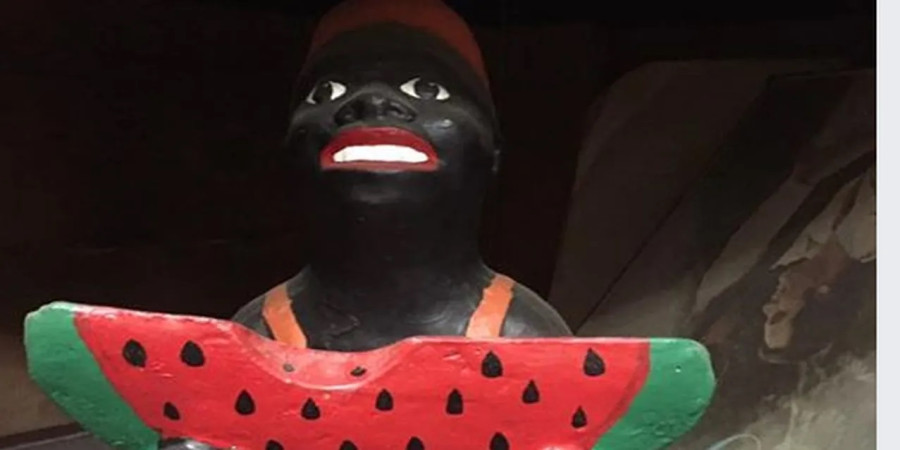

Beyond the Rind: Why Statues of Black People Eating Watermelon Are Racist
Strolling through a park, you might encounter a whimsical statue depicting a grinning Black child digging into a juicy slice of watermelon. It seems like a harmless scene, right? Well, hold on for a second. These seemingly innocuous statues perpetuate a racist stereotype with a long and ugly history.
Caricatures of Black people indulging in watermelon became prominent in the late 19th century. Minstrel shows, a form of racist entertainment, popularized the image. These shows depicted Black people as lazy, simple, and obsessed with watermelon. The stereotype went beyond amusement; it fueled racist ideologies that denied Black people intelligence and agency. Watermelons, readily available and cheap, were seen as a stereotypical Black food choice, reinforcing the idea of Black poverty and inferiority (https://kids.britannica.com/students/article/watermelon/277667).
This racist imagery seeped into popular culture, with watermelon imagery appearing in advertisements, postcards, and even merchandise, all portraying Black people in a demeaning light ([invalid URL removed]). Statues featuring this stereotype are not just outdated relics; they actively contribute to the persistence of racial bias.
Here's why these statues matter:
- Symbolism Matters: Statues are powerful symbols that reflect our values and cultural narratives. A statue of a Black person solely defined by their consumption of watermelon reinforces racist stereotypes and implies that watermelon is the pinnacle of Black cultural contributions.
- Perpetuating Bias: Exposure to racist stereotypes, even in seemingly harmless forms, can negatively impact how people perceive Black individuals. These statues can contribute to racial microaggressions, where subtle verbal and nonverbal cues communicate racist ideas.
- Erasing History: Public spaces should reflect the richness and diversity of a community. Statues that perpetuate racist stereotypes erase the true narratives of Black people and their contributions to society.
So, the next time you see a statue depicting this stereotype, remember the history it represents. These statues don't celebrate Black joy; they demean Black people and contribute to racial bias. Let's move beyond these racist depictions and create public spaces that celebrate the true stories of all members of our society.
Moving Forward: Dismantling Racist Symbolism
The presence of statues depicting Black people eating watermelon in public spaces is a stark reminder of the deep-rooted racism that continues to plague society. These statues are not merely harmless relics of the past; they actively contribute to the perpetuation of harmful stereotypes and the erosion of Black dignity.
To dismantle these racist symbols and create a more equitable society, we must take concerted action:
1. Public Awareness and Education:
- Engage in Open Dialogue: Initiate open discussions about the harmful nature of these statues and the stereotypes they represent. Encourage community members to share their perspectives and experiences.
- Educate the Public: Provide educational resources and workshops that delve into the history of racist stereotypes and their impact on Black communities.
2. Community Involvement and Action:
- Community Forums: Organize community forums to discuss the removal of these statues and brainstorm alternative ways to represent Black history and culture in public spaces.
- Petition and Advocacy: Encourage community members to sign petitions and advocate for the removal of these statues from public spaces.
3. Artistic Expression and Counter-Narratives:
- Public Art Projects: Support public art projects that challenge racist stereotypes and celebrate the diversity and resilience of Black communities.
- Community Storytelling: Encourage storytelling initiatives that amplify the voices of Black individuals and showcase their rich cultural heritage.
By taking these steps, we can begin to dismantle the legacy of racism and create a more inclusive society that celebrates the contributions of all its members. The removal of statues depicting Black people eating watermelon is not just a symbolic gesture; it's a tangible step towards dismantling the structures of oppression that continue to marginalize Black communities.
Let's work together to create a future where public spaces reflect the true stories and experiences of all people, free from the burden of racist stereotypes and harmful symbolism.
Popular articles

Apr 11, 2024 07:40 PM

May 25, 2024 08:09 PM

Apr 11, 2024 07:22 PM

Apr 10, 2024 07:59 PM

Mar 14, 2024 07:53 PM
Comments (0)